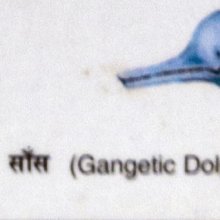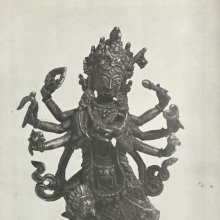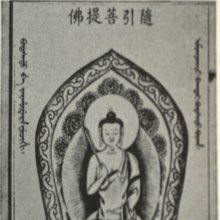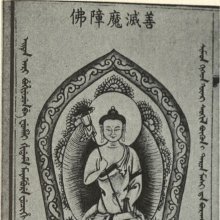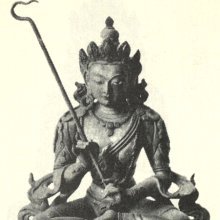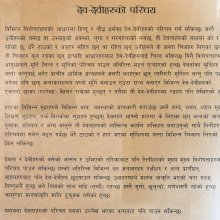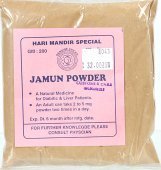Can, Cāṇ, Caṉ, Caṇ, Caṅ: 11 definitions
Introduction:
Can means something in Hinduism, Sanskrit, Tamil. If you want to know the exact meaning, history, etymology or English translation of this term then check out the descriptions on this page. Add your comment or reference to a book if you want to contribute to this summary article.
Alternative spellings of this word include Chan.
Images (photo gallery)
(+1926 more images available)
In Hinduism
Vyakarana (Sanskrit grammar)
Source: Wikisource: A dictionary of Sanskrit grammarCaṅ (चङ्).—A Vikarana affix of the aorist substituted for च्लि (cli) after roots ending in the causal sign णि (ṇi), as also after the roots श्रि, द्रु (śri, dru) and others; this चङ् (caṅ) causes reduplication of the preceding root form; cf. P. III 1.48-50, e. g. अचूचुरत्, अशिश्रियत् (acūcurat, aśiśriyat); cf. also P. VII. 4.93.
--- OR ---
Caṇ (चण्).—The indeclinable च (ca) (with ण् (ṇ) as a mute letter added to it which of course disappears) possessing the sense of चेत् (cet) or condition. e.g. अयं च मरिष्यति (ayaṃ ca mariṣyati) cf. Kas, on P. VIII. 1.30.

Vyakarana (व्याकरण, vyākaraṇa) refers to Sanskrit grammar and represents one of the six additional sciences (vedanga) to be studied along with the Vedas. Vyakarana concerns itself with the rules of Sanskrit grammar and linguistic analysis in order to establish the correct context of words and sentences.
Languages of India and abroad
Sanskrit dictionary
Source: DDSA: The practical Sanskrit-English dictionaryCaṇ (चण्).—1 P. (caṇati)
1) To sound.
2) To go.
3) To injure, hurt, kill.
--- OR ---
Can (चन्).—1, 6. P. [चनति (canati)]
1) To sound.
2) To hurt, injure, kill.
Source: Cologne Digital Sanskrit Dictionaries: Shabda-Sagara Sanskrit-English DictionaryCaṇ (चण्).—[caṇa] r. 1st cl. (caṇati) 1. To give. 2. To sound. 3. To hurt or kill. bhvā-parasaka-seṭ .
--- OR ---
Can (चन्).—[cana] r. 1st. and 10th cls. (canati, cānayati) To hurt, to injure in any manner, to wound or kill, &c. 2. To believe, to confide. 3. To make a sound. bhvā-para saka-seṭ . curā-para-saka-seṭ .
Source: Cologne Digital Sanskrit Dictionaries: Benfey Sanskrit-English DictionaryCaṇ (चण्).—i. 1, [Parasmaipada.] 1. To give (or to go, to kill). 2. To sound, v. r.
Source: Cologne Digital Sanskrit Dictionaries: Cappeller Sanskrit-English DictionaryCan (चन्).—(only aor. caniṣṭam) delight in, enjoy.
Source: Cologne Digital Sanskrit Dictionaries: Monier-Williams Sanskrit-English Dictionary1) Caṇ (चण्):—(cf. √can) [class] 1. [Parasmaipada] ṇati, to give, [Dhātupāṭha xix, 34];
—to go, [ib.];
—to injure, [ib.];
—to sound ([varia lectio] for √vaṇ), [xiii, 3] :—[Causal] [Aorist] acicaṇat, or acacāṇat, [Pāṇini 7-4, 3; Siddhānta-kaumudī]
2) Can (चन्):—1. can [class] 1. nati, to sound, utter a sound, [cf. Lexicographers, esp. such as amarasiṃha, halāyudha, hemacandra, etc.];
2) —to hurt, injure, [Dhātupāṭha xix, 41.]
3) 2. can (cf. √kan), only [Aorist] [subjunctive] 2. [dual number] caniṣṭam ‘to delight in, be satisfied with ([locative case])’ [Ṛg-veda vii, 70, 4];—and 3. sg. caniṣṭhat ([jan, [Sāma-veda]]), ‘to satisfy, please’ [Ṛg-veda viii, 74, 11.]
Source: Cologne Digital Sanskrit Dictionaries: Yates Sanskrit-English Dictionary1) Caṇ (चण्):—caṇati 1. a. To give; sound; kill.
2) Can (चन्):—(ki) canati cānayati 1. 10. a. To hurt; to believe; to sound.
[Sanskrit to German]
Sanskrit, also spelled संस्कृतम् (saṃskṛtam), is an ancient language of India commonly seen as the grandmother of the Indo-European language family (even English!). Closely allied with Prakrit and Pali, Sanskrit is more exhaustive in both grammar and terms and has the most extensive collection of literature in the world, greatly surpassing its sister-languages Greek and Latin.
Tamil dictionary
Source: DDSA: University of Madras: Tamil LexiconCaṉ (சன்) noun < Urdu san. Year; வருடம். [varudam.] Local usage
--- OR ---
Cāṇ (சாண்) noun [Telugu: jāna, K. gēṇ, M. cāṇ.] Span, as a measure = nine inches; ஒன்பதங்குல முள்ள அளவு. எண்சா ணளவா லெடுத்த வுடம்புக்குள் [onpathangula mulla alavu. ensa nalava ledutha vudambukkul] (திருமந். [thiruman.] 2127).
Tamil is an ancient language of India from the Dravidian family spoken by roughly 250 million people mainly in southern India and Sri Lanka.
Nepali dictionary
Source: unoes: Nepali-English DictionaryCan is another spelling for कन [kana].—n. 1. the chaff of wheat; 2. a small grain; 3. a minute chip;
Nepali is the primary language of the Nepalese people counting almost 20 million native speakers. The country of Nepal is situated in the Himalaya mountain range to the north of India.
See also (Relevant definitions)
Starts with (+18): Cadragra, Cana, Cana-Kana-Kara-Dini-Dishi, Canaa, Canabhojin, Canaca, Canacana, Canacananem, Canacanata, Canacanita, Canadruma, Canaga, Canage, Canagi, Canah, Canaiya, Canaka, Canakala, Canakalavana, Canakaloni.
Query error!
Full-text (+39744): Samdesha, Samkoca, Sannivesha, Samtushta, Sannikarsha, Samgraha, Samtosha, Samghata, Sannivishta, Shankari, Shan, Shanmukha, Samtrasa, Sanmarga, Samgata, Samtapita, Sannaddha, Samkshobha, Samtarana, Sannikrishta.
Relevant text
Search found 672 books and stories containing Can, Cāṇ, Caṉ, Caṇ, Caṅ, Chan, Saan, San; (plurals include: Cans, Cāṇs, Caṉs, Caṇs, Caṅs, Chans, Saans, Sans). You can also click to the full overview containing English textual excerpts. Below are direct links for the most relevant articles:
Altan Chan und die Qalmaq in der Chronik des Seyfi Celebi < [Volume 32 (1970)]
The Bstan rcis of Nii ma bstan 'jin: Transcription of the Tibetan text < [Volume 33 (1971)]
An annotated syllabary of Sathewok Hakka < [Volume 28 (1963)]
Rig Veda (translation and commentary) (by H. H. Wilson)
Maha Prajnaparamita Sastra (by Gelongma Karma Migme Chödrön)
Act 10.9: The transformed Sahā universe compared with the Padmāvatī universe < [Chapter XV - The Arrival of the Bodhisattvas of the Ten Directions]
The 22 main Bodhisattvas < [Chapter XIII - The Buddha-fields]
Part 1 - The Buddha is omniscient, independent, without a teacher < [Chapter III - General Explanation of Evam Maya Śruta]
Archives of Social Sciences of Religions
Understanding Zen: Encounter, Transformation, and Genealogy in Chan Buddhism < [Volume 130 (2005)]
Reviving the Temple: Atmosphere and Devotion in Benares < [Volume 128 (2004)]
Sorcery and Power Dynamics in Haiti: An Exploration < [Volume 48-1 (1979)]
Indian influences in the Philippines (by Juan R. Francisco)
Sanskrit words for respect in Filipino language < [Chapter 1 - Sanskrit in the Philippine languages]
Shapatha Motif (or, Saccakiriya—The Act of Truth) < [Chapter 5 - Indian Literature in the Philippines—Folk-literature motifs]
Calling the Wind < [Chapter 4 - Indian Literature in the Philippines]
Vernacular architecture of Assam (by Nabajit Deka)
Related products
(+159 more products available)
